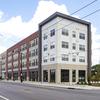Developers in metro Denver are churning out so many luxury apartments it is depressing rents in the priciest neighborhoods, forcing landlords to provide more concessions and shrinking the premium tenants pay to live downtown.
But is it a bubble ready to burst? The real estate community remains divided about what comes next as a record number of units continue to hit the market in Denver.
“I personally believe that Denver is overbuilt,” Kelley Klobetanz, chief underwriter at Greystone & Co. in Denver., told attendees at a multifamily conference hosted by Bisnow in Cherry Creek on Thursday.
Charlie Williams, a senior vice president at KeyBank in Denver, countered that for four years observers have worried about overbuilding in apartments. He even passed on deals that looked too speculative, only to see them succeed.
Maybe it takes 18 months instead of 14 to fill a building, or more concessions need to be offered, but every time a new project hits the market, it eventually gets filled, he said.
“We are a market that is diversified finally. Denver isn’t a boom and bust town anymore,” he said.
Dan Levin, a regional development partner with Miami-based Pensam Development, said today’s projects are financed much more conservatively than those from before the last downturn, when banks pushed out loans with only 5 percent down.
Lenders are still requiring developers to put 20 percent to 35 percent equity into a deal, a substantial cushion should things not go as planned.
“It is about standing the test of time,” he said. “You need adequate reserves to withstand the cycle.”
But that doesn’t mean the market isn’t straining to absorb what is being built. David Pierce, a market analyst with CoStar Group, detailed the downward pressure all the new supply is having.
Looking at Class A space, the newest and highest quality units, annual rent increases over the past five years have run 1.9 percent downtown, 4.1 percent elsewhere in the Denver area and 2.7 percent nationally. About one in seven units downtown come with concessions like a month or more of free rent versus 1 in 10 elsewhere.
Five years ago, a developer who built or purchased Class A units outside Denver’s core would have enjoyed rent increases of 20 percent versus only 10 percent for those who followed the herd and stayed in the urban core, Pierce’s numbers show.
Related Articles
-
Seniors won’t provide quick answer to shortage of metro Denver family homes
-
U.S. economy adds 200K jobs in August as pay rises most in nine years
-
Chill taking hold in metro Denver’s housing market
-
Senior citizen wave coming to Colorado’s Garfield County as Baby Boomers enter golden years
-
Hancock: Keeping Denver’s housing market in reach for all Denverites
So what are developers doing? Last year, they increased the supply of downtown units by about two-thirds over the annual average going back to 2014. They are doubling down rather than pulling back.
In the most expensive submarkets, like Cherry Creek and the Golden Triangle, rents are falling. One notable exception is LoDo, where the pairing of a Whole Foods Market under the Union Denver apartments has proven a big draw. It filled up easily and without any concessions.
Another warning sign comes in the narrowing spread in rents between Class A units downtown and the older or lower quality Class B and C units. Typically, tenants have paid a 50 percent rent premium to live downtown in the nicest units, but now the gap is only 25 percent, and even lower once concessions are included.
“The premium to live downtown has narrowed,” said Pierce, who offered a silver lining.
If the new construction slows or stops, that rent premium should increase again. Those who own units downtown will benefit.

